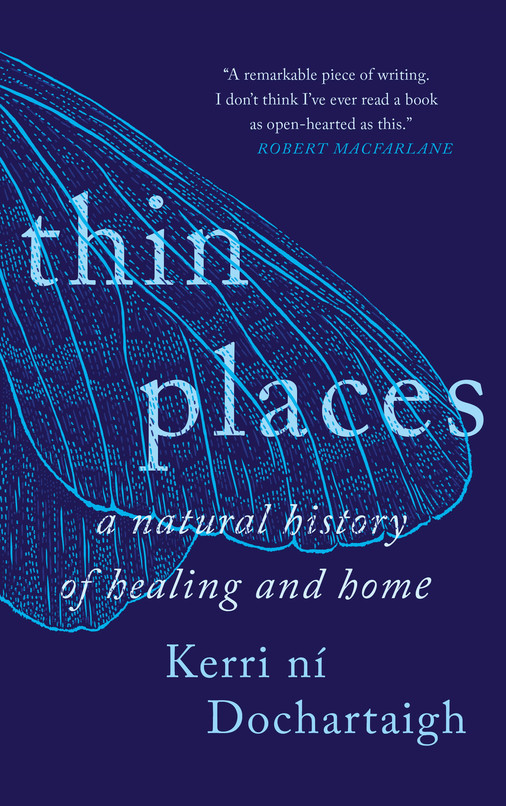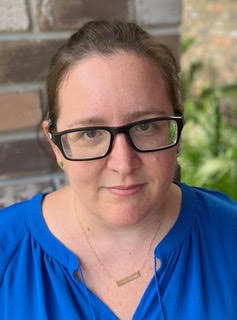Reviewed by Emily Webber
 Grief is a country that has no definite borderlines and that recognises no single trajectory. It is a space that did not exist before your loss, and that will never disappear from your map, no matter how hard you rub at the charcoal lines. You are changed utterly, and your personal geography becomes yours and yours only.
Grief is a country that has no definite borderlines and that recognises no single trajectory. It is a space that did not exist before your loss, and that will never disappear from your map, no matter how hard you rub at the charcoal lines. You are changed utterly, and your personal geography becomes yours and yours only.
Ní Dochartaigh, author of Thin Places: A Natural History of Healing and Home, was born in Derry, Ireland, in 1983 to a Catholic mother and Protestant father. She unsparingly recounts how we enact senseless violence on each other. Ní Dochartaigh initially lived in the Protestant area until shortly after her parents divorced, when her father moved out and the family home was petrol bombed. It is a nasty message that the family is no longer welcome in the Protestant area without her father. They move to the Catholic area and are eventually bullied out of there. Whenever ní Dochartaigh finds some measure of safety in her life, it is pulled out from underneath her, and she struggles to feel at home anywhere.
Ní Dochartaigh recounts the harrowing experiences of her parents and friends and details the anguishing effects that show up in addiction, mental illness, and suicide. There is a heavy darkness over much of this memoir. Even when ní Dochartaigh moves away from Ireland, her past haunts her. She attempts to leave her entire past there. She doesn’t share what she has lived through with others and so doesn’t process any of it herself. She can’t trust people; she’s depressed, drinks too much, runs from place to place and has suicidal thoughts.
It is a little disorienting at first when ní Dochartaigh lets in bits of light through folklore, connection with the land, and eventually healing. She’s speaking in a way many of us are unaccustomed to in our daily life, a way that is both meditative and otherworldly. Mixing the mystical and magical with the harsh reality of our world, she is giving us a new language to explore and asking us to see what is beyond our direct line of vision.
“Heaven and earth, the Celtic saying goes, are only three feet apart, but in thin places that distance is even shorter. They are places that make us feel something larger than ourselves, as though we are held in place between worlds, beyond experience. After years of visiting such places away from Ireland, I heard a voice calling me back, a soft but insistent cry: a call back to my own áiteanna tanaí.”
Eventually, she gives in to the pull to move back home and reconnect with the land. The threat of violence looms again as the country grapples with Brexit. It is a reminder that peace isn’t guaranteed. Inspired by her grandfather’s stories and his talk of thin places, ní Dochartaigh begins to forge a path to her own healing. She begins to learn her ancestors’ ways and connection with places they lived and with a language that treats the existence of “other dimensions” as a given. She connects the heartache of how she grew up with how we are living out of balance with the natural world. Ní Dochartaigh reclaims the Irish language and her history and looks to the land for both comfort and change. Many readers of this memoir will understand this feeling better because, during the pandemic, we have realized that the outdoors can offer a sense of safety and comfort. In observing and being in the natural world, one can find the courage and relief in a feeling that there is something more than the moment we are in and something beyond us.
“You listen to swans that you don’t know then are called whooper swans. You wonder why they keep coming back to land at all. Why would they ever choose to land in your part of the world? You watch murmurations of starlings on yet another night of rioting, and you want to know what the birds know. What draws them towards one another in dance. What keeps them so close together and what taught them how to gather, how to be so delicate with one another.”
She beautifully weaves together politics, her personal story, and writing on nature. As she draws closer to nature and the history of her people, she becomes more whole. When ní Dochartaigh speaks of thin places, she is not just taling about places of great beauty that easily inspire awe, like the Grand Canyon or Stonehenge. The thinnest place she experienced “was at the periphery of a field, at the top of a laneway, looking down onto a rough, sectarian housing estate.” At length, she describes a canal by her home with its butterflies, mayflies, and moths that bring a sense of safety. Finally, she opens up to a few people and sees a future version of herself that isn’t entirely weighted down by trauma and grief. When we can see the possibility of a different version, hope and change become a reality.
Kerri ní Dochartaigh’s memoir, Thin Places, implores us to look at the land we are living on—the pond in our backyard, the glittering moths in the parking lot, the otter dipping and swirling in the canal. Turning to the natural world helps us settle into ourselves and know that, while our lives are complicated, we are tied to something greater than ourselves that can help us become more whole.
 Emily Webber’s writing has appeared in The Writer magazine, the Ploughshares Blog, Five Points, Maudlin House, Brevity, and Slip Lip Magazine. She’s the author of a chapbook of flash fiction, Macerated, from Paper Nautilus Press. Find more at emilyannwebber.com and on Twitter: @emilyannwebber.
Emily Webber’s writing has appeared in The Writer magazine, the Ploughshares Blog, Five Points, Maudlin House, Brevity, and Slip Lip Magazine. She’s the author of a chapbook of flash fiction, Macerated, from Paper Nautilus Press. Find more at emilyannwebber.com and on Twitter: @emilyannwebber.


